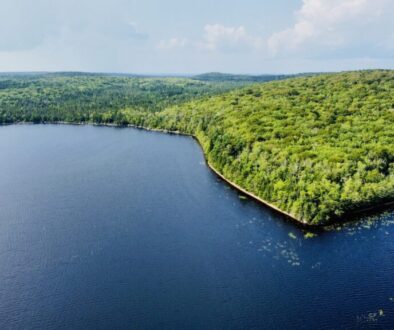Nova Scotia creates 14 new and expanded protected areas including Sackville River Wilderness Area
KJIPUKTUK / HALIFAX – Sackville River Wilderness Area is now protected!!
The Nova Scotia government announced today that it has completed the legal designation process for public lands in the Upper Sackville and Beaver Bank area.
Sackville River Wilderness Area was included in the 2013 Nova Scotia Our Parks and Protected Areas Plan. It has gone through several rounds of public consultation, including most recently in spring 2021. In total, 800 hectares of public land are now legally-protected.
“Today is a day to celebrate,” says Chris Miller, Executive Director of the Nova Scotia Chapter of the Canadian Parks and Wilderness Society (CPAWS-NS). “The communities of Upper Sackville and Beaver Bank have been waiting a long time for this new protected area to happen. We are so happy that it is finally done and that this important natural area is now officially established as a legally-designated wilderness area.”
Congratulations to the Sackville Rivers Association (SRA), who have worked so hard to protect these public lands going back more than a decade. We especially want to thank Walter Regan, the founder and past-president of SRA, for his long-time advocacy and dedication to conserving these lands.
Sackville River Wilderness Area protects numerous important ecosystems, including large intact landscapes, old-growth hardwood forests, important headwater lakes, frontage on the Sackville River, significant wetlands, a key wildlife corridor, and species-at-risk habitat for Atlantic salmon, snapping turtles, and common nighthawk. It also forms the northern boundary of the Halifax Greenbelt.
The area is popular for outdoor recreation, including hiking, fishing, hunting, biking, cross-country skiing, and swimming. Located adjacent to the protected area is the Girl Guides Camp at Lewis Lake. With the protected area designation now complete, all of these activities can continue without any interruption. The protected area prohibits industrial disturbances that are incompatible with conservation objectives, such as clearcutting, open-pit mining, or building new roads. The protected area designation also means that a planned clearcut near Hawkin Hall Lake has now been permanently terminated.
Through the designation process, the protected area boundary for Sackville River Wilderness Area has increased in size from 631 hectares to 800 hectares. The protected area was expanded to include additional public lands on the eastern side of the wilderness area. In 2020, CPAWS-NS conducted a boundary assessment of Sackville River Wilderness Area and recommended to the Nova Scotia government an expansion to the protected area boundary at this location to better protect floodplain forests, vernal pools, wetlands, and recreational opportunities, among other conservation values. It also brings the entirety of Hawkin Hall Lake into the protected area boundary.
“We welcome the expanded protected area boundary,” says Miller. “This is consistent with the CPAWS-NS recommendation to better protect key conservation features on the eastern side of the protected area.”
The protection of the Sackville River site was initially proposed as a nature reserve, but was changed by the Nova Scotia government to a wilderness area designation in response to local feedback and recommendations from SRA and CPAWS-NS.
Also included in today’s announcement are 6 new nature reserves and 7 expanded wilderness areas. These include:
- Barneys River Nature Reserve
- Big Meadow Brook Nature Reserve
- Cherry Hill Beach Nature Reserve
- Glendyer Nature Reserve
- Les Caps Nature Reserve
- Porcupine Brook Nature Reserve
- Eastern Shore Islands Wilderness Area expansion
- Economy River Wilderness Area expansion
- Eigg Mountain – James River Wilderness Area expansion
- Medway Lakes Wilderness Area expansion
- Middle River – Framboise Wilderness Area expansion
- Portapique River Wilderness Area expansion
- Wentworth Valley Wilderness Area expansion
Collectively, these sites include large intact forests, coastal beaches and islands, significant wetlands and waterways, and species-at-risk habitat.
The Nova Scotia government is also providing $20 million in new funding for the “Nova Scotia Crown Share Land Legacy Fund”, which will help with private land conservation by providing matching funding for land trusts.
The United Nations Biodiversity Conference COP15 is currently underway in Montreal. A total of 195 countries are negotiating a new international conservation agreement, which will include higher protected area targets. The Earth is facing an ecological catastrophe with the dual crises of the climate emergency and collapse of biodiversity. Negotiators in Montreal have until December 19th to reach a final agreement.
“I’m pleased that the Nova Scotia government finalized this latest batch of new protected areas in time for the COP15 conference,” says Miller, who is attending the COP15 negotiations. “It helps build momentum for reaching a final agreement and demonstrates that protected area establishment is a key strategy to halt and reverse the decline of biodiversity.”
Last year, the Nova Scotia government committed to legally-protecting at least 20% of the provincial landmass by 2030 and enshrined this new target in law. They also committed to fully implementing all of the remaining undesignated sites within the 2013 Nova Scotia Our Parks and Protected Areas Plan and included this commitment within the Ministerial Mandate Letters for the Department of Environment and Climate Change and the Department of Natural Resources and Renewables.
CPAWS-NS looks forward to the next batch of new protected areas within the near future.
Contact:
Chris Miller
cmiller@cpaws.org
High resolution photos available


